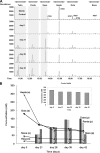Reductive debromination of polybrominated diphenyl ethers by anaerobic bacteria from soils and sediments
- PMID: 20008168
- PMCID: PMC2812996
- DOI: 10.1128/AEM.01872-09
Reductive debromination of polybrominated diphenyl ethers by anaerobic bacteria from soils and sediments
Abstract
Polybrominated diphenyl ethers (PBDEs) have attracted attention recently due to their proven adverse effects on animals and their increasing concentrations in various environmental media and biota. To gain insight into the fate of PBDEs, microcosms established with soils and sediments from 28 locations were investigated to determine their debromination potential with an octa-brominated diphenyl ether (octa-BDE) mixture consisting of hexa- to nona-BDEs. Debromination occurred in microcosms containing samples from 20 of the 28 locations when they were spiked with octa-BDE dissolved in the solvent trichloroethene (TCE), which is a potential cosubstrate for stimulating PBDE debromination, and in microcosms containing samples from 11 of the 28 locations when they were spiked with octa-BDE dissolved in nonane. Debromination products ranging from hexa- to mono-BDEs were generated within 2 months. Notably, the toxic tetra-BDEs accounted for 50% of the total product. In sediment-free culture C-N-7* amended with the octa-BDE mixture and nonane (containing 45 nM nona-BDE, 181 nM octa-BDEs, 294 nM hepta-BDE, and 19 nM hexa-BDE) there was extensive debromination of the parent compounds, which produced hexa-BDE (56 nM), penta-BDEs (124 nM), and tetra-BDEs (150 nM) within 42 days, possibly by a metabolic process. A 16S rRNA gene-based analysis revealed that Dehalococcoides species were present in 11 of 14 active microcosms. However, unknown debrominating species in some of the microcosms debrominated the octa-BDE mixture in the absence of other added halogenated electron acceptors (such as TCE). These findings provide information that is useful for assessing microbial reductive debromination of higher brominated PBDEs to less-brominated congeners, a possible source of the more toxic congeners (e.g., penta- and tetra-BDEs) detected in the environment.
Figures




Similar articles
-
Identification of Reductive Dehalogenases That Mediate Complete Debromination of Penta- and Tetrabrominated Diphenyl Ethers in Dehalococcoides spp.Appl Environ Microbiol. 2021 Aug 11;87(17):e0060221. doi: 10.1128/AEM.00602-21. Epub 2021 Aug 11. Appl Environ Microbiol. 2021. PMID: 34160266 Free PMC article.
-
Pathways for the anaerobic microbial debromination of polybrominated diphenyl ethers.Environ Sci Technol. 2008 Apr 15;42(8):2845-52. doi: 10.1021/es0720917. Environ Sci Technol. 2008. PMID: 18497133
-
Isolation of Acetobacterium sp. strain AG, which reductively debrominates octa- and pentabrominated diphenyl ether technical mixtures.Appl Environ Microbiol. 2013 Feb;79(4):1110-7. doi: 10.1128/AEM.02919-12. Epub 2012 Nov 30. Appl Environ Microbiol. 2013. PMID: 23204415 Free PMC article.
-
Polybrominated diphenyl ether flame retardants in the U.S. marine environment: a review.Environ Int. 2009 Apr;35(3):655-66. doi: 10.1016/j.envint.2008.11.001. Epub 2008 Dec 18. Environ Int. 2009. PMID: 19100622 Review.
-
Polybrominated diphenyl ethers: human tissue levels and toxicology.Rev Environ Contam Toxicol. 2004;183:55-97. doi: 10.1007/978-1-4419-9100-3_3. Rev Environ Contam Toxicol. 2004. PMID: 15369322 Review.
Cited by
-
Interaction of polybrominated diphenyl ethers and aerobic granular sludge: biosorption and microbial degradation.Biomed Res Int. 2014;2014:274620. doi: 10.1155/2014/274620. Epub 2014 May 29. Biomed Res Int. 2014. PMID: 25009812 Free PMC article.
-
Distribution and Chemical Analysis of Pharmaceuticals and Personal Care Products (PPCPs) in the Environmental Systems: A Review.Int J Environ Res Public Health. 2019 Aug 21;16(17):3026. doi: 10.3390/ijerph16173026. Int J Environ Res Public Health. 2019. PMID: 31438569 Free PMC article. Review.
-
Pine needles as biomonitors of polybrominated diphenyl ethers and emerging flame retardants in the atmosphere of Shanghai, China: occurrence, spatial distributions, and possible sources.Environ Sci Pollut Res Int. 2019 Apr;26(12):12171-12180. doi: 10.1007/s11356-019-04558-8. Epub 2019 Mar 4. Environ Sci Pollut Res Int. 2019. PMID: 30830665
-
Occurrence and Risk Assessment of Polybrominated Diphenyl Ethers in Surface Water and Sediment of Nahoon River Estuary, South Africa.Molecules. 2022 Jan 27;27(3):832. doi: 10.3390/molecules27030832. Molecules. 2022. PMID: 35164097 Free PMC article.
-
Spatial distribution, source analysis, and ecological risk assessment of PBDEs in river sediment around Taihu Lake, China.Environ Monit Assess. 2020 Apr 23;192(5):309. doi: 10.1007/s10661-020-08286-2. Environ Monit Assess. 2020. PMID: 32328811
References
-
- Bezares-Cruz, J., C. T. Jafvert, and I. Hua. 2004. Solar photodecomposition of decabromodiphenyl ether: products and quantum yield. Environ. Sci. Technol. 38:4149-4156. - PubMed
-
- Björklund, J., P. Tollbäck, C. Hiärne, E. Dyremark, and C. Östman. 2004. Influence of the injection technique and the column system on gas chromatographic determination of polybrominated diphenyl ethers. J. Chromatogr. A 1041:201-210. - PubMed
-
- Boon, J. P., W. E. Lewis, M. R. Tjoen-A-Choy, C. R. Allchin, R. J. Law, J. de Boer, C. C. ten Hallers-Tjabbes, and B. N. Zegers. 2002. Levels of polybrominated diphenyl ether (PBDE) flame retardants in animals representing different trophic levels of the North Sea food web. Environ. Sci. Technol. 36:4025-4032. - PubMed
-
- Bunge, M. L., A. K. Adrian, M. Opel, W. G. Lorenz, J. R. Andreesen, H. Görisch, and U. Lechner. 2003. Reductive dehalogenation of chlorinated dioxins by an anaerobic bacterium. Nature 421:357-360. - PubMed
-
- de Wit, C. A. 2002. An overview of brominated flame retardants in the environment. Chemosphere 46:583-624. - PubMed
Publication types
MeSH terms
Substances
Associated data
- Actions
- Actions
- Actions
- Actions
- Actions
- Actions
- Actions
- Actions
LinkOut - more resources
Full Text Sources
Molecular Biology Databases

